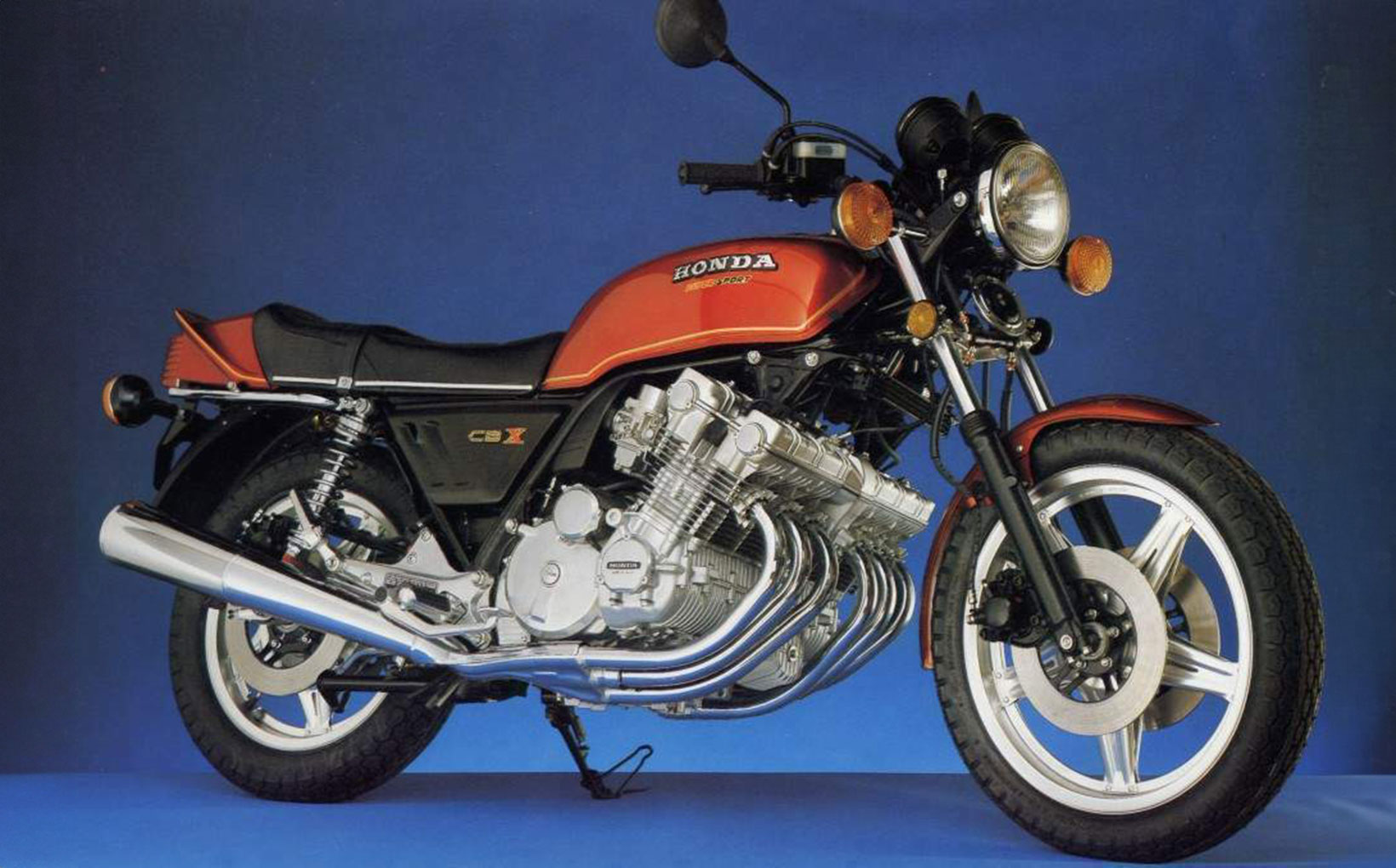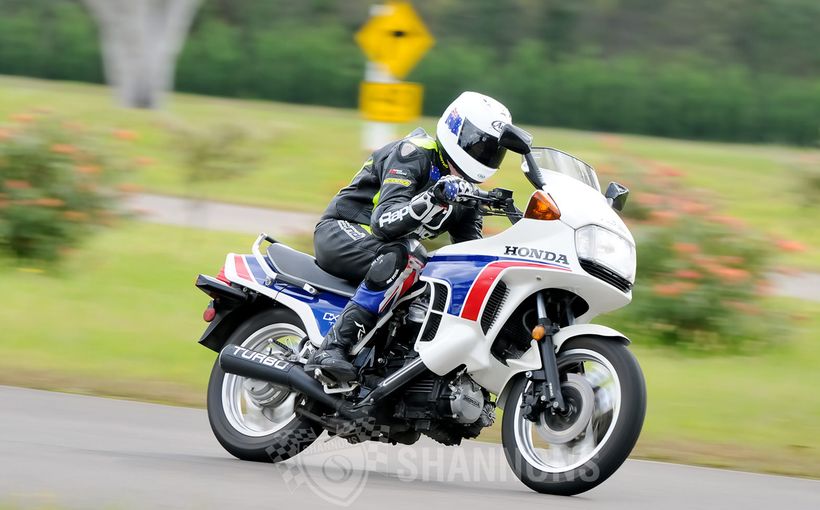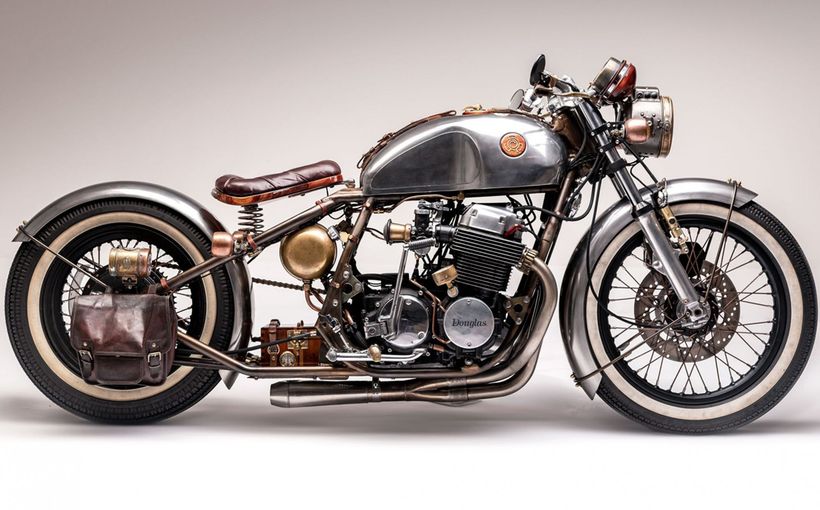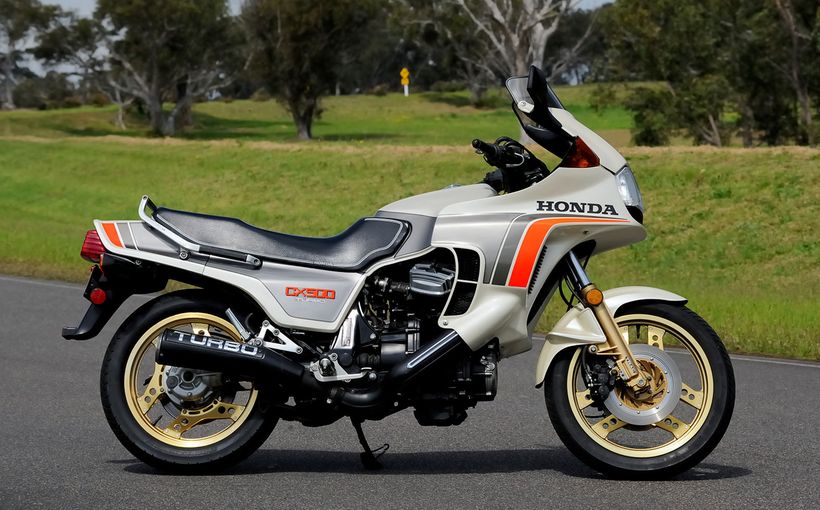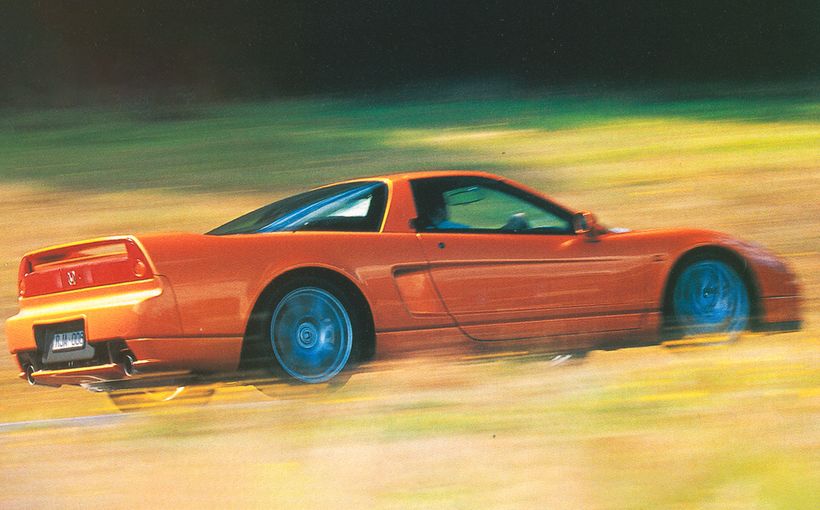CBX 1000: Honda’s Grand Prix-inspired six-cylinder masterpiece

Six cylinders. Six carburettors. Dual overhead camshafts. Twenty-four valves. 1047cc. 105bhp. 140mph. The superbike world had never seen anything like Honda’s CBX when launched in 1978.
Sure, Italian manufacturer Benelli had created the world’s first production six in 1972 with its triple-carb SOHC 12-valve 750Sei (Italian for six), which curiously drew design inspiration from Honda’s CB500 four with two cylinders added.
However, Honda seriously raised the bar with the CBX, inspired by the company’s iconic four-stroke six-cylinder Grand Prix racers of the 1960s, which in the sublime hands of Mike Hailwood delivered emphatic world championships for the Japanese marque.
The motorcycle press raved about the CBX’s velvet smoothness and massive, unrelenting surge of power. Its towering 105bhp (78kW) at 9000rpm set a new benchmark in the escalating Japanese superbike war of the late 1970s, which left contemporaneous four-cylinder rivals like the Kawasaki Z1-B (82bhp), Suzuki GS1000 (90bhp) and Yamaha XS1100 (95bhp) in its wake.

Image: Honda
“The objective – to build the fastest production motorcycle for sale anywhere in the world – has been met,” wrote Cycle magazine. It also claimed the CBX was the most advanced entry into the superbike market, calling it a “breakthrough for the Japanese motorcycle industry.”
Other publications praised the CBX as “the Vincent Black Shadow of 1979.” Another called it “magic” and predicted it would be ranked with the “rare and precious motorcycles which will never, ever be forgotten.”
Yet for all its advanced engineering, immense power, shattering top speed and glowing road-test reviews, the CBX never attracted the sales Honda rightly expected of its new flagship. It was in showrooms for barely four years before production ceased in 1982, with total production of around 40,000 units.
By comparison, Honda sold more than 230,000 of its revered CB750 predecessor in its first four years, plus another 325,000 during its remaining years in production.
So, why did such a groundbreaking motorcycle fail to match its famous CB ancestor, which turned the motorcycle world on its head a decade before? It’s an intriguing question, particularly in light of the widespread appreciation of the CBX by today’s enthusiasts. We find the answer in this review.

Image: https://en.wheelsage.org/
Another bold concept
In historical terms the CBX can be seen as a logical development of the Japanese production superbike, which started with Honda’s seminal CB750 in the late 1960s and progressed through the equally iconic Kawasaki 900 Z1 and Suzuki GS1000 in the 1970s.
Cycle World’s Kevin Cameron best described this era: “The essence of this development was to put ever-larger, more powerful and heavier air-cooled four-stroke engines into chassis of a 1960s technical level.”
However, by the mid-1970s there was a growing perception that Honda had been basking for too long in the afterglow of the CB750. It was still turning out well-engineered and reliable machinery, but many felt Honda had become too cautious and conservative with its outright superbike development. It needed another sledgehammer. A global game-changer.

Image: https://www.sae.org/news/2023/04/honda-gp-engines
Design work for the CBX (we assume the X denoted Extreme), was assigned to a team of engineers with in-house competition experience, led by Shoichiro Irimajiri who created the jewel-like 250cc and 297cc across-the-frame-six-cylinder GP engines for Hailwood’s revered RC166 and RC174 racers of the 1960s.
He was also responsible for the innovative liquid-cooled flat-four in the iconic Honda Gold Wing which set new benchmarks for smoothness and effortless cruising in the long distance touring market.
The intention was for the CBX - like its GP ancestors - to blow the competition into the weeds, with a bike that could not only hit an unprecedented 140mph (225km/h) straight off the showroom floor but also represent such a giant leap in engine technology that awe-struck buyers could not resist it.
To develop another inline four, no matter how powerful, would have lacked the sheer ‘wow’ factor needed. Given his background, Irimajiri’s plan for a six-cylinder Honda renaissance – only this time in series production form - was not surprising.

Image: https://en.wheelsage.org/
Six of the best
Design work commenced in 1975 and within two years the CBX had progressed from concept to pre-production prototype. Its majestic inline six was big on GP design inspiration and looked formidable, protruding from each side of a frame that almost seemed too small to contain it.
However, visual perceptions were not matched by dimensions. Fact is, the CBX engine spanned 23.4-inches (594mm), which was only 50mm wider than the original CB750 - and that had two less cylinders.
In a Cycle Guide review, L.J.K Setright made the following observation about the CBX: “Don’t tell me that its engine is too wide: it is no wider than the legs of a rider, so it adds nothing to the frontal area and personally I would rather have my legs shielded by a cylinder apiece than exposed to every blow.”
A key design element was moving the alternator and ignition units from each end of the crankshaft to a jackshaft behind the cylinder block (see cutaway). This not only resulted in engine width that allowed exceptional angles of cornering lean, but also placed these delicate components out of harm’s way if it went to ground.

Image: Honda
The crankshaft was a robust and elegant one-piece steel forging. However, mindful of its extra length and potential vibration issues, Irimajiri drew on his racing experience by transferring power from the centre of the crankshaft via silent chain to the jackshaft behind the cylinder block.
So, the jackshaft drove not only the relocated alternator/ignition units but also the massive 13-plate wet clutch, five-speed gearbox and primary chain-drive to the rear wheel.
Honda GP design could also be seen in the dual overhead camshafts, which like the crank were driven from their centres. Therefore, each was effectively two shorter shafts to eliminate vibration, with the exhaust cam driven by silent chain from the crank while a shorter chain coupled it with the inlet cam.

Image: https://en.wheelsage.org/
Both camshafts operated four valves per cylinder through inverted-bucket tappets. The wide 62.6-degrees valve angle not only created hemispherical-shaped combustion chambers but also allowed enough space for cooling fins between the cam-covers.
The bank of six air-cooled cylinders were inclined forward at a 30-degree angle to ensure they could fit neatly beneath a conventional (20-litre) fuel tank.
Six inline 28mm Keihin carburettors were neatly arranged in a V-formation, which angled the rear of the carburettor bodies inboard to keep their combined width as slender as possible. And although the CBX engine was 50mm longer than the CB750, the gap between its foot-pegs was narrowed by 60mm, highlighting Honda’s emphasis on minimising width.
The exhaust system was also a visual feast, comprising a pair of three-into-one primaries with each neatly merging at collectors under the gearbox and emerging as long single mufflers on each side.

Image: https://en.wheelsage.org/
More GP technology could be seen in the CBX frame design, given that the engine was a stressed chassis member with no frame structure passing beneath it like a traditional full-cradle.
This offered numerous advantages given that it greatly reduced weight, simplified routing of the six primary exhaust pipes and eased removal of the carburettors for servicing by undoing the top engine bolts and lowering the front of the engine.
Suspension comprised telescopic front forks and adjustable coil-over rear dampers. Honda opted to use the same Comstar rivetted five-spoke aluminium wheels first seen on the CB750F2 but the rear tyre seemed too small for such a powerful machine (as Honda would discover in the Castrol Six Hour). Front brakes were dual 11-inch solid discs clamped by single-piston calipers paired with a single 12-inch disc/caliper at the rear.
Despite Honda’s obvious efforts to minimise weight, which included forged-aluminium handlebars and foot-pegs and even some magnesium components, the CBX’s 272kg wet weight added to perceptions that the CBX was a giant of a motorcycle in more ways than one.
However, Yamaha’s four-cylinder shaft-drive XS1100 rival was slightly heavier, so in terms of power-to-weight ratios Honda was the leader of the pack.

Image: Honda
Too much of a good thing?
“A few journalists were lucky enough to test the pre-production models at the Honda-owned Suzuka race track following the press conference in 1977 and all came away flabbergasted,” wrote Jim Scaysbrook in his review for Old Bike Australasia.
“The overwhelming sentiment was that the CBX, which at first glance looked ridiculously monstrous and ungainly, at least in the engine department, was actually a supremely comfortable, well mannered, fine handling and practical motorcycle, that indisputably oozed panache. It was an instant classic, an absolute traffic stopper, king of the kids and king of the road.”
The CBX-Z (to use its full model name) was competitively priced and following its launch in late 1978, Cycle World ran a sizzling quarter-mile time of 11.64 secs at 118mph (190km/h) and claimed that the CBX was the first production bike it had tested that could exceed 130mph (210km/h). By comparison, the same publication ran 11.78 secs at 114mph on a stock Yamaha XS1100.
Soon after that benchmark was set, the CBX's quarter-mile time dropped to 11.36 seconds and numerous publications authenticated its 140mph (225km/h) top speed. Cycle Guide claimed that “the CBX engine is as responsive as a racer, the nicest cycle motor to ever reach the street.”

Image: https://amcn.com.au/editorial/days-of-thunder-amaroo-park/
These opinions were vindicated when Honda airfreighted a CBX from Japan to Australia in August 1978, where in Michael Cole’s hands it powered to a debut victory in the Calder Two-Hour race in Melbourne. That was the first race win anywhere in the world for the CBX.
As a result, several teams entered CBX 1000s in the prestigious Castrol Six-Hour that followed, at Sydney’s tight and twisty Amaroo Park. One of them set pole position and another (co-ridden by Calder winner Cole) was leading with around 90 minutes remaining when forced to pit to replace a worn-out rear tyre (it probably was too small), resulting in a painfully long stop and eventual third-place finish.
Even so, Honda’s new flagship had proven its performance on the race track and in its first full year of production the company sold 25,000 of them, which while respectable was less than half of the 53,400 sales achieved by the first CB750K0.
Scaysbrook: “For all its charisma, the CBX didn’t really catch on to the extent that Honda had undoubtedly anticipated. Its sheer presence was perhaps just too imposing for many and in terms of machines of comparable performance, there were plenty of options in the marketplace.”

Image: Honda
Those included the Kawasaki Z1B, Yamaha XS1100 and Suzuki GS1000, which were all genuine superbikes without the overtly-wide appearance and perceived complexity of Honda’s six.
Potential CBX buyers also feared it would require constant trips to the dealership for specialised tuning and maintenance, when in fact it was no more difficult to maintain and keep in tune than a CB750.
The six also created perceptions of being too unwieldy for a superbike, when in fact the CBX had no handling vices and offered excellent angles of lean during cornering. Strong performances in production bike racing were proof of its sporting prowess.
Its reputation was also tarnished in the US because some early CBX-Zs were reportedly shipped with a faulty ignition advance, which reduced power output to around 85bhp.
As a result, word on the street quickly spread of CBXs getting hosed by their contemporaneous Japanese rivals, which made many question the wisdom of Honda’s strategy of using extra cylinders to go slower. Although the ignition problem was soon fixed, the reputational damage had been done and it stuck.
Global sales dipped sharply in 1980 and despite Honda’s best attempts to revamp the CBX as more of a sports tourer rather than an outright superbike, with the 1980 CBX-A, 1981 mono-shock CBX-B and 1982 CBX-C variants, sales continued to slide and production ceased late in 1982.

Image: Honda
Modern appreciation
Ironically, the same majestic engine that turned buyers away from the CBX in its heyday lies at the heart of the model’s surging popularity as a Japanese super classic today.
It enjoys enthusiastic support across dedicated CBX owners’ clubs around the world, including the International Honda CBX Motorcycle Owners Association. In 2011, Two Wheels magazine also included the CBX as one of the publication’s favourite 12 superbikes ever.

Image: Honda
Its desirability as a collectable (particular the original twin-shock model) continues to grow, as today’s aficionados share an appreciation of its unique engineering and rider engagement, which is in stark contrast to buyer response decades ago.
Reminds us of a line from a famous Joni Mitchell song: “Don’t it always seem to go that you don’t know what you’ve got ‘til it’s gone?” A succinct description of the once-maligned but magnificent Honda CBX 1000.

